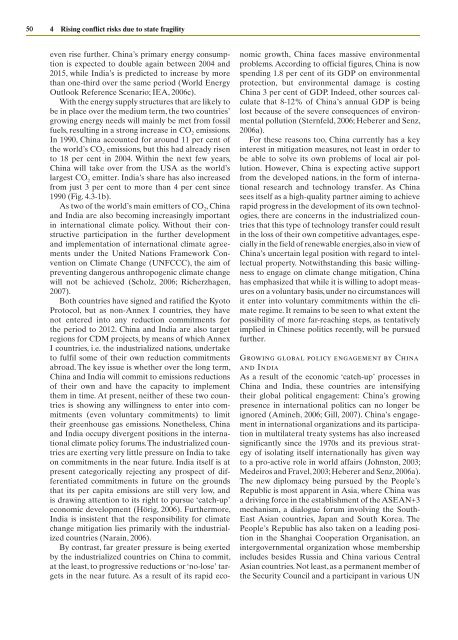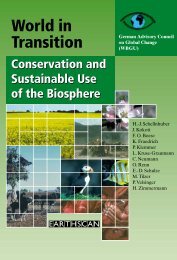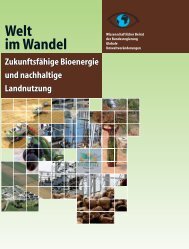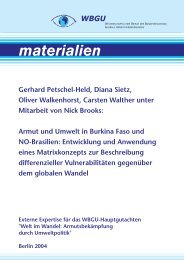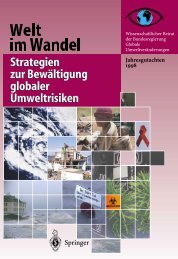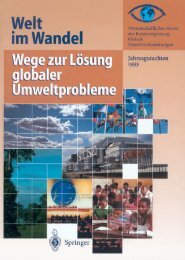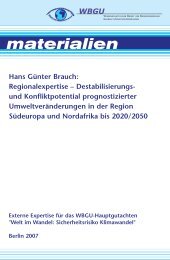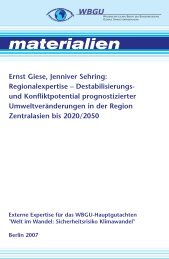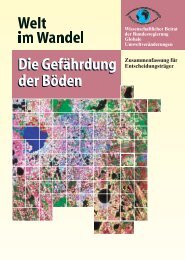World in Transition: Climate Change as a Security Risk - WBGU
World in Transition: Climate Change as a Security Risk - WBGU
World in Transition: Climate Change as a Security Risk - WBGU
Create successful ePaper yourself
Turn your PDF publications into a flip-book with our unique Google optimized e-Paper software.
50 4 Ris<strong>in</strong>g conflict risks due to state fragility<br />
even rise further. Ch<strong>in</strong>a’s primary energy consumption<br />
is expected to double aga<strong>in</strong> between 2004 and<br />
2015, while India’s is predicted to <strong>in</strong>cre<strong>as</strong>e by more<br />
than one-third over the same period (<strong>World</strong> Energy<br />
Outlook Reference Scenario; IEA, 2006c).<br />
With the energy supply structures that are likely to<br />
be <strong>in</strong> place over the medium term, the two countries’<br />
grow<strong>in</strong>g energy needs will ma<strong>in</strong>ly be met from fossil<br />
fuels, result<strong>in</strong>g <strong>in</strong> a strong <strong>in</strong>cre<strong>as</strong>e <strong>in</strong> CO 2 emissions.<br />
In 1990, Ch<strong>in</strong>a accounted for around 11 per cent of<br />
the world’s CO 2 emissions, but this had already risen<br />
to 18 per cent <strong>in</strong> 2004. With<strong>in</strong> the next few years,<br />
Ch<strong>in</strong>a will take over from the USA <strong>as</strong> the world’s<br />
largest CO 2 emitter. India’s share h<strong>as</strong> also <strong>in</strong>cre<strong>as</strong>ed<br />
from just 3 per cent to more than 4 per cent s<strong>in</strong>ce<br />
1990 (Fig. 4.3-1b).<br />
As two of the world’s ma<strong>in</strong> emitters of CO 2, Ch<strong>in</strong>a<br />
and India are also becom<strong>in</strong>g <strong>in</strong>cre<strong>as</strong><strong>in</strong>gly important<br />
<strong>in</strong> <strong>in</strong>ternational climate policy. Without their constructive<br />
participation <strong>in</strong> the further development<br />
and implementation of <strong>in</strong>ternational climate agreements<br />
under the United Nations Framework Convention<br />
on <strong>Climate</strong> <strong>Change</strong> (UNFCCC), the aim of<br />
prevent<strong>in</strong>g dangerous anthropogenic climate change<br />
will not be achieved (Scholz, 2006; Richerzhagen,<br />
2007).<br />
Both countries have signed and ratified the Kyoto<br />
Protocol, but <strong>as</strong> non- Annex I countries, they have<br />
not entered <strong>in</strong>to any reduction commitments for<br />
the period to 2012. Ch<strong>in</strong>a and India are also target<br />
regions for CDM projects, by means of which Annex<br />
I countries, i.e. the <strong>in</strong>dustrialized nations, undertake<br />
to fulfil some of their own reduction commitments<br />
abroad. The key issue is whether over the long term,<br />
Ch<strong>in</strong>a and India will commit to emissions reductions<br />
of their own and have the capacity to implement<br />
them <strong>in</strong> time. At present, neither of these two countries<br />
is show<strong>in</strong>g any will<strong>in</strong>gness to enter <strong>in</strong>to commitments<br />
(even voluntary commitments) to limit<br />
their greenhouse g<strong>as</strong> emissions. Nonetheless, Ch<strong>in</strong>a<br />
and India occupy divergent positions <strong>in</strong> the <strong>in</strong>ternational<br />
climate policy forums. The <strong>in</strong>dustrialized countries<br />
are exert<strong>in</strong>g very little pressure on India to take<br />
on commitments <strong>in</strong> the near future. India itself is at<br />
present categorically reject<strong>in</strong>g any prospect of differentiated<br />
commitments <strong>in</strong> future on the grounds<br />
that its per capita emissions are still very low, and<br />
is draw<strong>in</strong>g attention to its right to pursue ‘catch-up’<br />
economic development (Hörig, 2006). Furthermore,<br />
India is <strong>in</strong>sistent that the responsibility for climate<br />
change mitigation lies primarily with the <strong>in</strong>dustrialized<br />
countries (Nara<strong>in</strong>, 2006).<br />
By contr<strong>as</strong>t, far greater pressure is be<strong>in</strong>g exerted<br />
by the <strong>in</strong>dustrialized countries on Ch<strong>in</strong>a to commit,<br />
at the le<strong>as</strong>t, to progressive reductions or ‘no-lose’ targets<br />
<strong>in</strong> the near future. As a result of its rapid eco-<br />
nomic growth, Ch<strong>in</strong>a faces m<strong>as</strong>sive environmental<br />
problems. Accord<strong>in</strong>g to official figures, Ch<strong>in</strong>a is now<br />
spend<strong>in</strong>g 1.8 per cent of its GDP on environmental<br />
protection, but environmental damage is cost<strong>in</strong>g<br />
Ch<strong>in</strong>a 3 per cent of GDP. Indeed, other sources calculate<br />
that 8-12% of Ch<strong>in</strong>a’s annual GDP is be<strong>in</strong>g<br />
lost because of the severe consequences of environmental<br />
pollution (Sternfeld, 2006; Heberer and Senz,<br />
2006a).<br />
For these re<strong>as</strong>ons too, Ch<strong>in</strong>a currently h<strong>as</strong> a key<br />
<strong>in</strong>terest <strong>in</strong> mitigation me<strong>as</strong>ures, not le<strong>as</strong>t <strong>in</strong> order to<br />
be able to solve its own problems of local air pollution.<br />
However, Ch<strong>in</strong>a is expect<strong>in</strong>g active support<br />
from the developed nations, <strong>in</strong> the form of <strong>in</strong>ternational<br />
research and technology transfer. As Ch<strong>in</strong>a<br />
sees itself <strong>as</strong> a high-quality partner aim<strong>in</strong>g to achieve<br />
rapid progress <strong>in</strong> the development of its own technologies,<br />
there are concerns <strong>in</strong> the <strong>in</strong>dustrialized countries<br />
that this type of technology transfer could result<br />
<strong>in</strong> the loss of their own competitive advantages, especially<br />
<strong>in</strong> the field of renewable energies, also <strong>in</strong> view of<br />
Ch<strong>in</strong>a’s uncerta<strong>in</strong> legal position with regard to <strong>in</strong>tellectual<br />
property. Notwithstand<strong>in</strong>g this b<strong>as</strong>ic will<strong>in</strong>gness<br />
to engage on climate change mitigation, Ch<strong>in</strong>a<br />
h<strong>as</strong> emph<strong>as</strong>ized that while it is will<strong>in</strong>g to adopt me<strong>as</strong>ures<br />
on a voluntary b<strong>as</strong>is, under no circumstances will<br />
it enter <strong>in</strong>to voluntary commitments with<strong>in</strong> the climate<br />
regime. It rema<strong>in</strong>s to be seen to what extent the<br />
possibility of more far-reach<strong>in</strong>g steps, <strong>as</strong> tentatively<br />
implied <strong>in</strong> Ch<strong>in</strong>ese politics recently, will be pursued<br />
further.<br />
Grow<strong>in</strong>g global policy engagement by Ch<strong>in</strong>a<br />
and India<br />
As a result of the economic ‘catch-up’ processes <strong>in</strong><br />
Ch<strong>in</strong>a and India, these countries are <strong>in</strong>tensify<strong>in</strong>g<br />
their global political engagement: Ch<strong>in</strong>a’s grow<strong>in</strong>g<br />
presence <strong>in</strong> <strong>in</strong>ternational politics can no longer be<br />
ignored (Am<strong>in</strong>eh, 2006; Gill, 2007). Ch<strong>in</strong>a’s engagement<br />
<strong>in</strong> <strong>in</strong>ternational organizations and its participation<br />
<strong>in</strong> multilateral treaty systems h<strong>as</strong> also <strong>in</strong>cre<strong>as</strong>ed<br />
significantly s<strong>in</strong>ce the 1970s and its previous strategy<br />
of isolat<strong>in</strong>g itself <strong>in</strong>ternationally h<strong>as</strong> given way<br />
to a pro-active role <strong>in</strong> world affairs (Johnston, 2003;<br />
Medeiros and Fravel, 2003; Heberer and Senz, 2006a).<br />
The new diplomacy be<strong>in</strong>g pursued by the People’s<br />
Republic is most apparent <strong>in</strong> Asia, where Ch<strong>in</strong>a w<strong>as</strong><br />
a driv<strong>in</strong>g force <strong>in</strong> the establishment of the ASEAN+3<br />
mechanism, a dialogue forum <strong>in</strong>volv<strong>in</strong>g the South-<br />
E<strong>as</strong>t Asian countries, Japan and South Korea. The<br />
People’s Republic h<strong>as</strong> also taken on a lead<strong>in</strong>g position<br />
<strong>in</strong> the Shanghai Cooperation Organisation, an<br />
<strong>in</strong>tergovernmental organization whose membership<br />
<strong>in</strong>cludes besides Russia and Ch<strong>in</strong>a various Central<br />
Asian countries. Not le<strong>as</strong>t, <strong>as</strong> a permanent member of<br />
the <strong>Security</strong> Council and a participant <strong>in</strong> various UN


